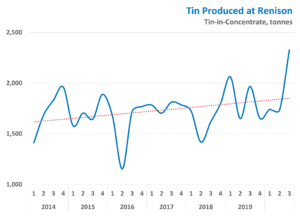Area 5 development has taken mine production at Renison to a new level, according to half-owner Metals X’s latest quarterly report.
 The impact of coronavirus in Australia has been limited compared to other tin mining countries – for instance those in South America. As a result, Bluestone Mines – the JV that operates Renison – has been able to continue the development of the new Area 5 without any issue.
The impact of coronavirus in Australia has been limited compared to other tin mining countries – for instance those in South America. As a result, Bluestone Mines – the JV that operates Renison – has been able to continue the development of the new Area 5 without any issue.
The Area 5 Optimisation Study was completed in June this year, allowing the project to move into its execution phase in July. This region of the mine contains significantly higher tin grades than areas mined in the last few years. As a direct result of Area 5 coming online, mined tin grades jumped from 1.19% Sn in Q2 2020 to 1.58%. In terms of metal, this increased the amount of mined tin by some 900 tonnes (2,500 to 3,414 tonnes).
On top of the work at Area 5, the Metallurgical Improvement Program is also underway. This project aims to improve systems within the process plant to improve throughput rates and increase metal recovery. Several parts of this program are now underway. However, the upgrade of the primary gravity spirals has been in improving tin recovery: in the third quarter, recoveries rose from 71.3% to 75.3%. As a result, tin produced from the mine during the quarter rose to 2,326 tonnes, up 600 tonnes from Q2 2020 (1,733 tonnes).
Our view: Results from this quarter’s report break the long-term trend of steadily increasing tin production at Renison. According to Metals X, September saw record monthly tin production at the mine, and the second highest recovery since the restart of the mine in 2008. With more work still to be done in both Area 5 and the Metallurgical Improvement Program, it seems likely that output could increase further in the final quarter of the year. Assuming this level of production continues for the next three quarters, our forecasts indicate that Metals X will hit its guidance of between 8,200 – 8,700 tonnes of tin-in-concentrate for FY2021.


